There is a fascinating moment of artistic synergy in the aesthetic production of the 20th century.
An architect, Le Corbusier, conceived an electronic poem, an electronic synthesis of visual and acoustic events, as well as a “vessel for the poem” (a pavilion) for the presentation of the Philips company at the 1958 World Exhibition in Brussels.
The result was one of the most exciting buildings of the post-war era, the Philips Pavilion, in which the electronic composition and the building form interrelated parts of a total work of art in which the elements of light, colourful images, rhythm and sound combine to form an organic synthesis.
Publication “From event structure to spatial form” @ Klangräume der Kunst, Kehrer Verlag, 7 Juli 2006
From event structure to spatial form
The sound architectures of Iannis Xenakis
There is a fascinating moment of artistic synergy in the aesthetic production of the 20th century. An architect, Le Corbusier, conceived an electronic poem, an electronic synthesis of visual and acoustic events, as well as a “vessel for the poem” (a pavilion) for the presentation of the Philips company at the 1958 World Exhibition in Brussels.
The result was one of the most exciting buildings of the post-war era, the Philips Pavilion, in which the electronic composition and the building form interrelated parts of a total work of art in which the elements of light, colourful images, rhythm and sound combine to form an organic synthesis.
Le Corbusier himself is working on the visual part of the Poème électronique, on the light show shown in the pavilion consisting of associatively compiled black and white stills documenting the history of mankind, which are superimposed with light and colour projections[1]. The composer Edgar Varèse is responsible for the acoustic part, a “spatialised” piece of music entitled Poème électronique. Iannis Xenakis[2], who – originally trained as an engineer – worked as an assistant to Le Corbusier and later became an internationally recognised composer, designed the concrete shell construction of the Philips Pavilion together with Le Corbusier.

← Notations of hyperbolic-paraboloid structures in Xenakis’ composition “Metastaseis” (1953-4)
→ Graphic notation of the musical composition “Pithoprakta” (1956) by Iannis Xenakis. The neologism “Pithoprakta” (Greek) can be translated into German as “probability actions”. The piece is an approximation of “stochastic”, i.e. (probability) music. The glissandi, which can perhaps be compared (visually) to straight lines, create sound volumes of constant transformation. The multitude of “punctual” tones distributed across the entire sound spectrum creates a dense “granulation”, a veritable cloud of changing sound material.In this piece, Xenakis uses the aesthetic principle of chance and the theory of probability (Maxwell’s and Bolzmann’s kinetic theory of gases) to create more complex mass structures that are not based on direct causal and deterministic laws, but on statistical laws.
Synthesis
according to
Le Corbusier
The pavilion, planned as a temporary structure, was demolished shortly after the end of the world exhibition and the memory of this unique creative achievement, of this collaboration between three artistic protagonists of the past century, gradually faded. For Le Corbusier, however, architecture as such was not at the centre of the pavilion; he saw this building mainly as a support, a “vessel”, for the visual and acoustic projections inside it.
The architectural discourse had difficulty dealing with the aspect of mediatisation, with the visual and acoustic events of the Poème électronique. For a long time, architectural theory avoided including the pavilion in its research; it was not easy to grasp or categorise, especially as its language appeared to be a foreign element in the context of Le Corbusier’s formal canon.
The recent rediscovery of the pavilion is closely linked to the search for models and paradigms for the development of contemporary architecture. The dynamic expression of the pavilion, with its hyperbolic-paraboloid and conical shells, is fascinating anew today, as architecture has expanded its vocabulary with more complex, “fluid” forms. In the light of this formal research, with the integration of more complex forms, stimulated by the latest development of digital design and construction tools, with the help of which three-dimensional complex structures can be realised, the search for the appropriate aesthetic is still ongoing.
Even if his modernist optimism centred on the technology of the future seems outdated, Le Corbusier’s Poème électronique continues to exert a strong fascination as a visual event. The electronic synthesis of the arts represented by the Philips company – as a pioneer in the development of mediatised environments (from light and sound to today’s “intelligently” networked devices and materials) – is an early example of a “vessel” or rather “container” architecture in the complex, multi-layered space of (media) flow. It is an early model of “hybrid” spaces in which the virtual is projected into our tactile world, creating a connection between digital and analogue environments in which visual and acoustic space merge with the material place.
Although the synthesis of the arts was inherent in Le Corbusier’s holistic approach, it remains unique in this form within his architectural oeuvre. Xenakis, however, continued his investigation both in the field of complex architectural forms and in that of complex ephemeral music and sound architectures.
He worked on a “poetics of the electronic age” by incorporating the possibilities opened up by the computer into his artistic work.
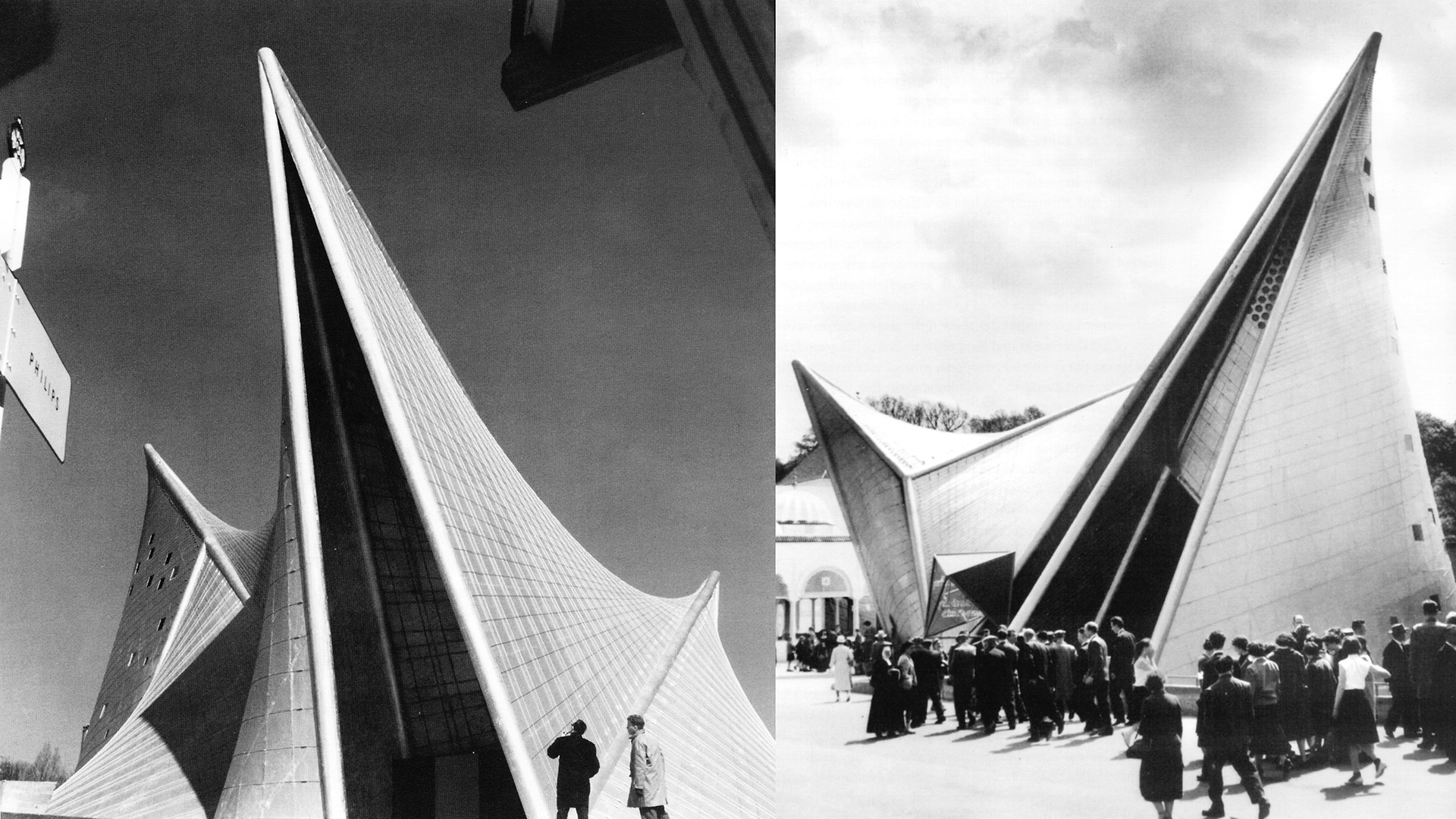
← Philips Pavilion, Brussels 1958.
→ Philips Pavilion, Brussels 1958.
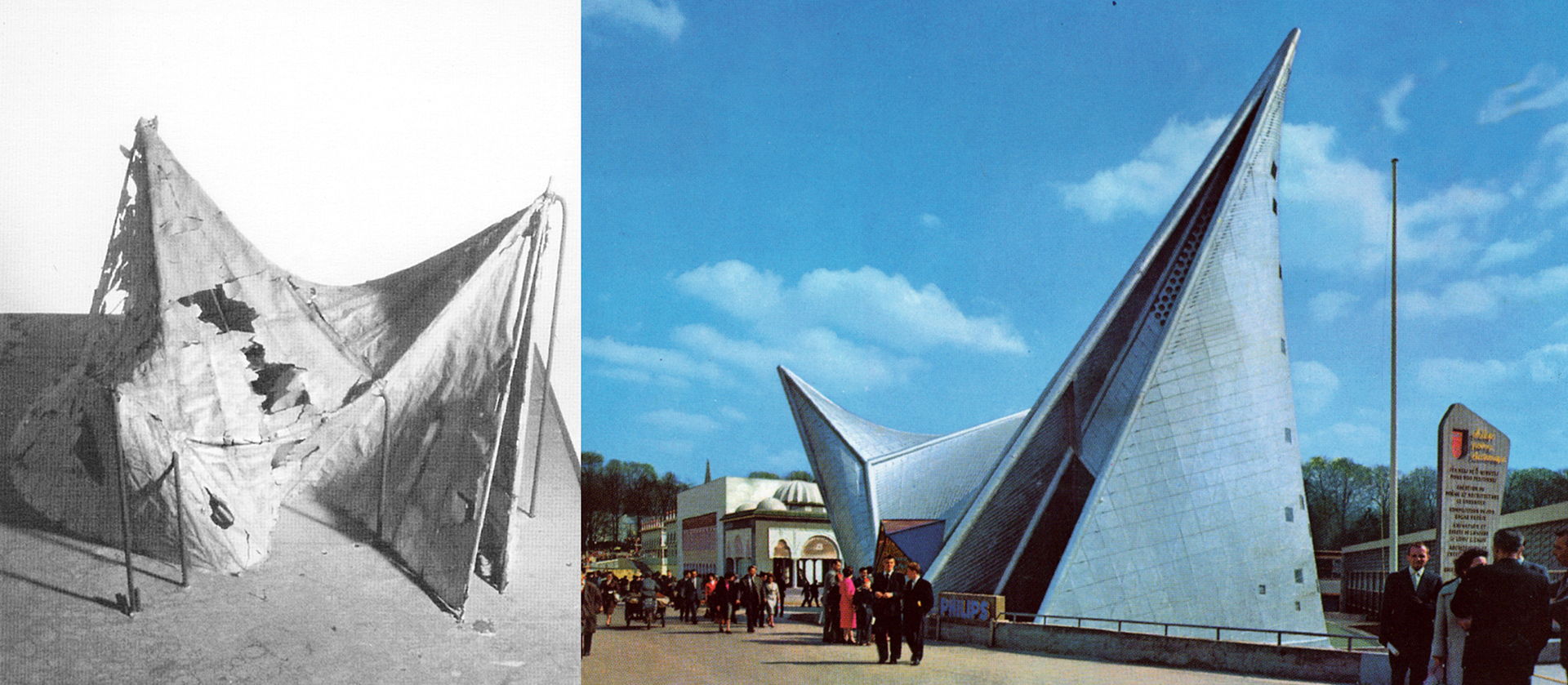
← Working model of the Philips Pavilion.
→ Postcard: Philips Pavillon, Brüssel 1958.
Design
generators
Xenakis’ personal design contribution to Le Corbusier’s office was a very specific one: he conceived elements that capture, direct and transform the light. For La Tourette monastery, for example, he designed the rhythmically structured façade, the pans de verre ondulatoires and the skylights, the “light cannons”.
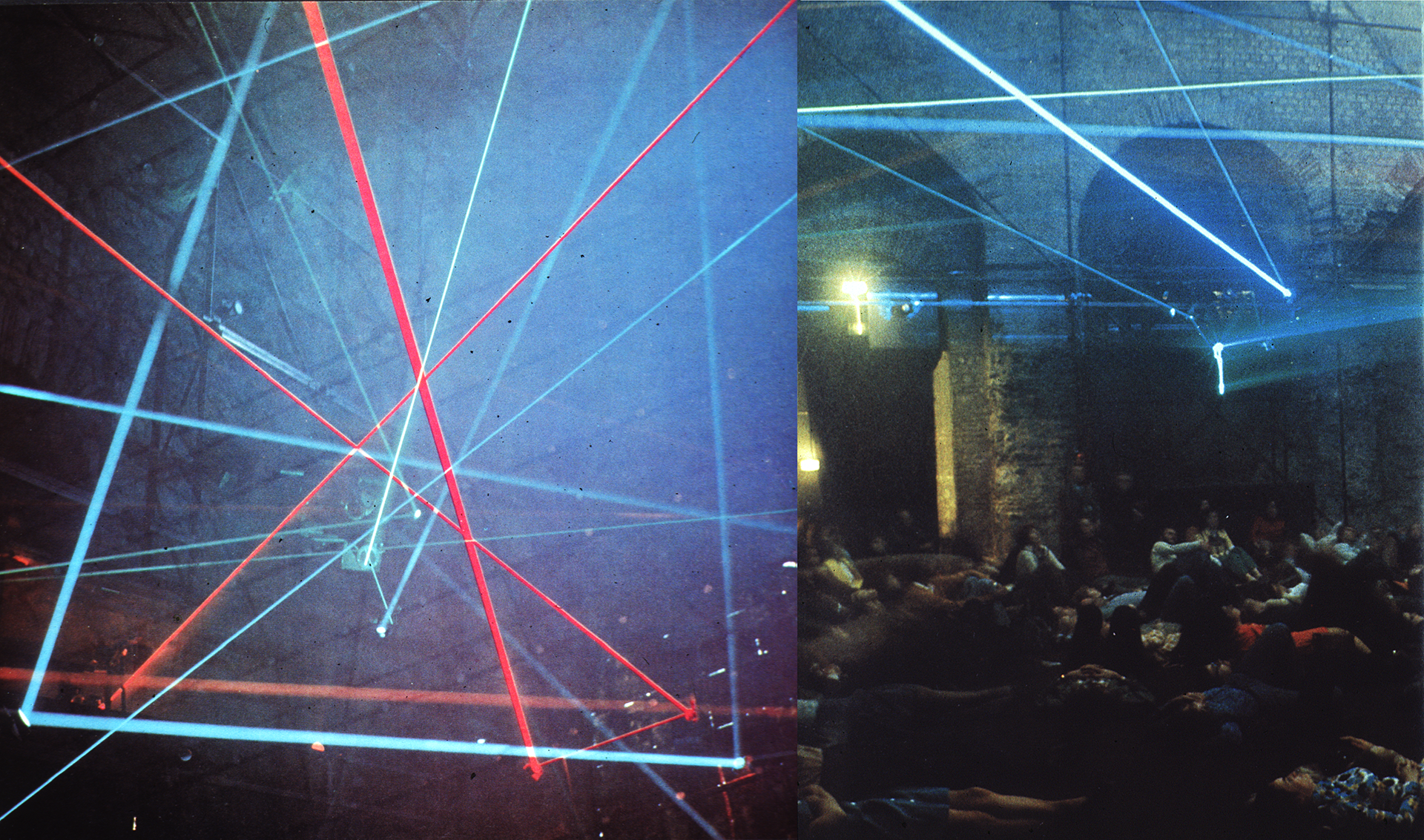
← → The “Polytope” in the Roman baths of Cluny in Paris 1972-74: a dymamic network of coloured laser beams modelled by rotating mirrors are superimposed with changing (almost continuous) pointillist “clouds of light” generated by flash lamps attached to the vault.
These “light architectures” were later developed further in Xenakis’ sound and light productions: in the Polytopes – the word refers to the superimposition of music and light, creating countless constantly changing, asynchronous places – or in Le Diatope, a combination of sound and light effects in a tent construction specially designed for this purpose.

← Model of the “Polytope” for the French pavilion at the Expo 67 world exhibition in Montreal.
→ Drawing of the “Polytope” for the French pavilion at the Expo 67 world exhibition in Montreal.
Xenakis’ (material) architectural production was limited. But in his architectural designs, such as the urban planning proposal for the Ville Cosmique (1964), in Le Diatope (Paris/Bonn 1978-79) or his competition entry for the Cité de la Musique in Paris (1984), he persistently searched for the three-dimensional – in the volumetric sense – complex architectural form. Most of these designs were based on hyperbolic paraboloids, which he had already used for the Philips Pavilion. As an engineer, Xenakis was familiar with gridded surfaces, hyperbolic-paraboloid and conical forms. These are not only formally remarkable in their continuity and complexity, but also in the way Xenakis structurally transfers them from one field to another: from engineering to music, from music to architecture. Before he worked on the Philips Pavilion, he had used hyperbolic-paraboloid structures as the basis for calculating his composition Metastaseis (1953-54): Line diagrams depicting the rising and falling tones of each individual instrument, in which glissandi form curved, rasterised sound surfaces. In his sound and light installation Polytope in Montreal (1967), Xenakis also created hyperbolic, paraboloid surfaces through the arrangement of the steel cables to which the lamps were attached.
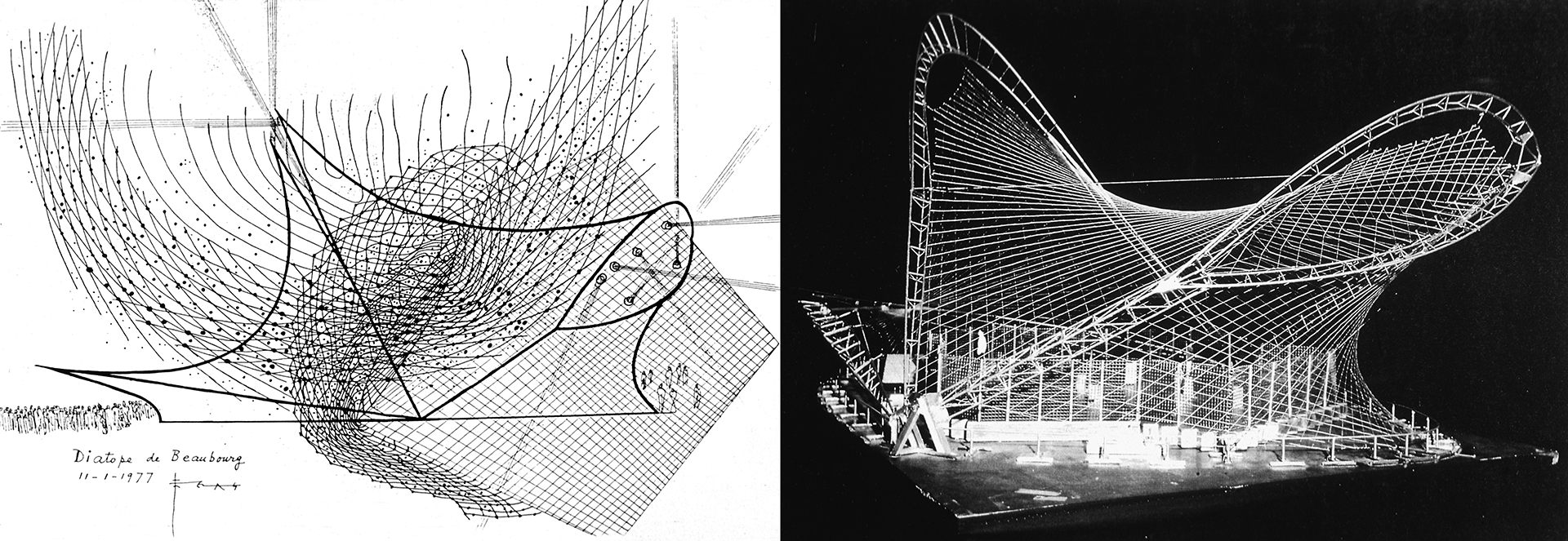
← → Model of the competition entry for the Cité de la Musique in Paris, 1984; Iannis Xenakis together with J.L. Véret. This work, which was selected for the prize group, deals with the search for an architectural framework for contemporary music events.
His dual sensibility for architecture and music enabled Xenakis to approach musical form in an architectural way and to compose architecture as a structure of (dynamic) relationships. By applying the same (intellectual) structures to two different fields, Xenakis opened the way to his strategy of transferring mathematical-scientific approaches to his artistic process. He utilised a whole series of “transfers” from the scientific world as design generators, such as Brownian motion – observed in gas molecules – mathematical probability theory (stochastic calculations) and group and chaos theory.
Xenakis’ transfer and use of scientific-mathematical methods thus serves more than just the practical solution to the problem of mastering the dynamic design of sound and light events, of organising the masses of “sound clouds” and “light galaxies” that he pursued compositionally. Rather, it is a fundamental approach to art, a kind of world view. Xenakis writes: “Music is a matrix for ideas, for energetic processes, for thought processes, for reflections on the physical reality that created and sustains us […], an expression of our visions of the universe, its waves, its ramifications, its people, as well as for the fundamental theories of theoretical physics, abstract logic, modern algebra […], music is world harmony, embodied in the light of contemporary thought.”
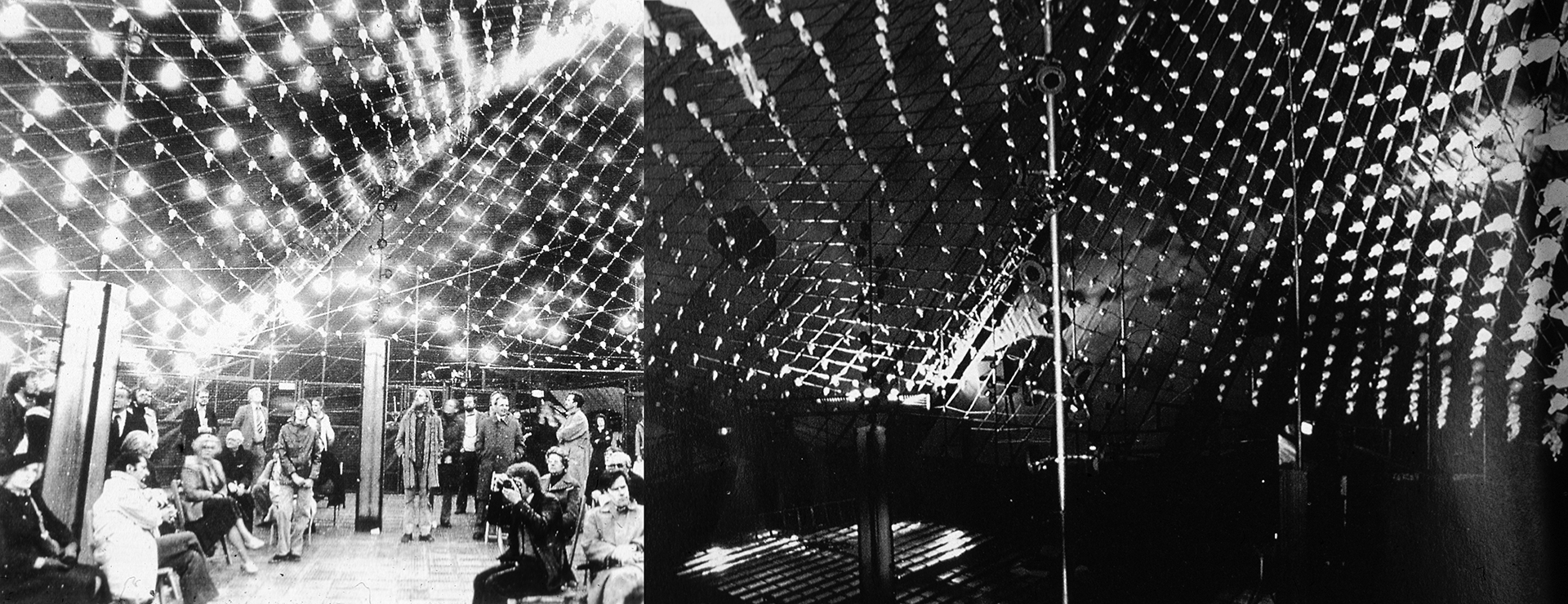
← → The “Polytope” in the Roman baths of Cluny in Paris 1972-74: a dymamic network of coloured laser beams modelled by rotating mirrors are superimposed with changing pointillist “clouds of light” generated by flash lamps attached to the vault.
Another of Xenaki’s inventions should be seen in this context: In the sixties, he began to develop his own computer. He used this special device to control and (de)synchronise the overlapping of musical and visual events (polytopes), but at the same time integrated it into his artistic work in order to compose his complex music. This instrument, the UPIC computer, links visual forms with acoustics via the bridge of mathematical information, reflecting Xenaki’s holistic understanding of form.
This digital tool is a music computer with a drawing board as an interface that is able to convert graphic information directly into music. This combination of the visual and the acoustic through mathematical information reflects Xenakis’ holistic approach to form, which he materialises in different media and dimensions, in sound, light, time and space.
Even if the realised architectural work occupies only a small part of Xenakis’ oeuvre, it is not a marginal part (as Le Corbusier accused him in the dispute over the authorship of the Philips Pavilion) but an important and integral part of his entire artistic production. Xenakis’ architectural experiments are very closely linked to his musical research and both are an expression of contemporary intelligence, of the same all-round creativity that forms the bridge of abstraction as a unifying element.
Xenakis also expressed his interest in formal structures in general and their acoustic, visual and architectural manifestations in his writings, in which he argues in favour of interdisciplinary research into form and proposes the development of a new discipline of a general “morphology” to deal with the understanding of form and its emergence. For Xenakis, architectural form has nothing to do with demarcation, but rather he seeks relationships and connections to a comprehensive formal understanding, as realised, for example, in his musical-visual works.
Morphologie
génerale
The hyperbolic paraboloids of the shells of the Philips Pavilion or the glissandi clusters of Metastaseis are three-dimensionally moving surfaces that are created by sliding a straight line along curves. Xenakis writes about the gridded, regulated and controlled double-curved surfaces: “The straight line allows the imagination of very complex forms with elements that are very easy to control.” For the engineer Xenakis, therefore, there are no “free” forms; curved surfaces can be captured mathematically/geometrically, their structured behaviour is determined. The architectural tradition of the 20th century, on the other hand, which was itself strongly influenced by the Corbusian canon, contrasts the “rational” (rectangularly gridded) form with the “free, irrational”, uncontrolled curve. Caught up in this contrast between the “rational”, simple geometric form and the uncontrolled, complex, “irrational” volumetry, architectural terminology is very imprecise in describing curved volumes. Although this contrast has long since been overcome, as science and mathematics have incorporated complexity and irregularity into their rational approach, architecture is only now developing a corresponding language. It was precisely in this environment that Xenakis advocated the development of a general discipline of form: “It is time to help the new science of a ‘morphologie générale’ achieve a breakthrough, which deals with the forms and architecture of these various disciplines in their ever-constant appearance as well as with the laws that determine their transformation.”
The hyperbolic paraboloid was Xenakis’ artistic trademark for a while. It is interesting that the form is not only considered in its continuity and complexity, but also in its transfer to other fields and from one field to another: from engineering to music, from music back to architecture.
A good example of such a transfer is the work Metastaseis, in which Xenakis adopts rhythmic structures that he has used in architecture. The temporal micro and macro structure of the work is based on the “harmonic” proportions of the golden ratio and the Fibonacci series: 1, 2, 3 (=1+2), 5 (=2+3), 8 (=3+5), 13 (=5+8) etc. These “harmonious” ratios of the golden ratio were a central theme in Le Corbusier’s architecture and the measurement system he developed, the “Modulor”, was based on them . Xenakis used these proportions, for example, to create the ondulatoires mentioned above in the façade of the monastery at La Tourette. Here again, the relationship between music (the unfolding of sound in time) and architecture (the unfolding of structure – in this case the façade – in space) becomes clear, whereby it is less about synaesthetic correspondences than about the transfer and “materialisation” of the same rhythmic structures in space and time. “It is human intelligence in a special stage of crystallisation, an intelligence that is searching, questioning, deducing, revealing and anticipating on all levels. It seems that music and art in general must necessarily be a crystallisation, a materialisation of this very intelligence.”
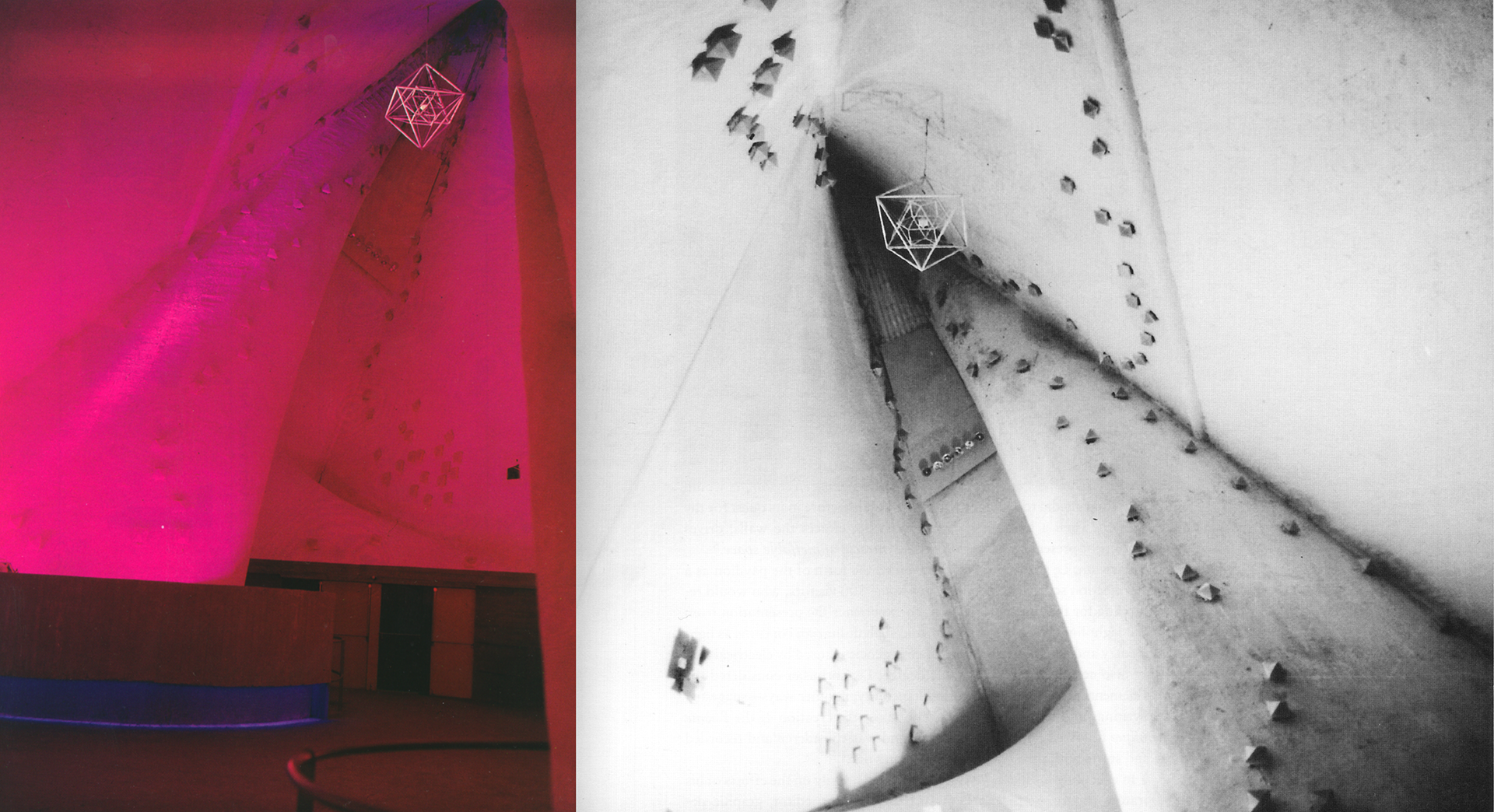
← Interior of the Philips Pavilion.
→ Interior of the Philips Pavilion in coloured light.
Xenakis’ relationship to the structures of music is clearly recognisable in his artistic production and his writings. The (complex) structures can be recreated retrospectively after hearing the piece and experiencing it in time, immersed in the musical moment. Music can be perceived in its ephemeral qualities as much as it can be a general experience of dynamic complex form. In this comprehensive mental understanding of musical form, according to Xenakis, it has a correspondence to the perception of architecture. “Knowledge of a building such as Nôtre Dame, for example, requires such observation, up close and from a distance, not simultaneously but successively and from different distances, so that one is able to penetrate the details, to feel them, to live them and also to understand the conception of the whole, little by little – which is often not possible except by walking around it. To gradually get to know the proportions and the entire architectural organism: so that you can grasp it in your thoughts.”
In his preoccupation with an architecture of events, Xenakis reveals a different approach to the dynamic perception of architecture than that formulated by Sigfried Giedion in “Space, Time, Architecture” .
Giedion, still very much in the tradition of the framed pictures of the English Garden, refers to the relativity of spatial sequences of material architecture. Xenakis, who works within multi-layered, multi-media environments, is interested in a global view, the intellectual (re-)construction of form and structure.
Contemporaries of Xenakis, such as the Situationists or the English experimental group of architects Archigram, have gone down in architectural history because they investigated the mediatisation of space. Their hedonistic, subversive approach was based on a pronounced interest in the social (communicative) aspect of the media, as is the case in pop(ulary) culture. Xenakis, on the other hand, stood in an idealistic-humanistic tradition. His borrowings, which are expressed in a musical, spatial and visual opus, range from ancient Greek philosophy to contemporary natural sciences. A last “homo universalis”?
Footnotes
1 Le Corbusier was assisted by the editor, publisher and graphic designer Jean Petit and the filmmaker Philippe Agostini.
2 The French-Greek composer, architect and engineer Iannis Xenakis died in Paris on 4 February 2001 at the age of 78. He is regarded as a pioneer of media architecture, the technological basis of which he helped to shape. He worked as a civil engineer and architect in Le Corbusier’s office in Paris from 1947 to 1960. After his break with Le Corbusier – there were differences of opinion over the authorship of the Philips Pavilion – he concentrated on his musical work and became one of the most important composers of the 20th century. However, he also continued to work on architectural projects from time to time.
3 “undulating glazed panels” see also Varga, Balint Andreas Conversations with Iannis Xenakis (London: Faber and Faber, 1996, p. 25) and interview by the author with Xenakis on 9 March 1995.
4 Polytopes of Montreal, Canada (1967), Polytopes of Osaka, Japan (1970), Polytopes of Persepolis, Iran (1971), Polytopes of Cluny, France (1972-74) and Polytopes of Mycènes, Greece (1978). For a documentation of the polytopes, see also: Revault d’Allonnes, Olivier, Xenakis/Polytopes Paris: Balland, 1975.
5 The work Diatope was planned for the inauguration of the Centre Georges Pompidou in Paris in February 1978. For technical reasons, however, it could only be realised in June 1978. A further station was in Bonn in 1979. See also: Centre Georges Pompidou: geste de lumiere et de son. Le Diatope-Xenakis (Paris: Centre Georges Pompidou, 1978) or Solomos, Makis and Jean-Michel Raczinski, “La Synthèse des Arts à l’ère du multi-média. À propos du Diatope de Iannis Xenakis”, Ateliers. Cahiers de la Maison de la Recherche Université Charles-de-Gaule – Lille III, Lille, 1999.
6 “La musique est une matrice d’idées, d’actions énergétiques, de processus mentaux, reflets à leur tour de la réalité physique qui nous a créés et qui nous porte et de notre psychisme clair et obscur. Expression des visions de l’univers de ses ondes, de ses arbres, de ses hommes au mème titre que les théories fondamentales de la physique théorique, de la logique abstraite, de l’algèbre moderne […] La musique est l’harmonie du monde mais homomorphisée par le domaine de la pensée actuelle.” Xenakis, Iannis, Musique-Architecture, p. 16.
7 UPIC: Unité Polyagogique du CEMAMu (Centre de Mathématique et Automatique musicales). In 1966 Xenakis founded the Équipe de mathématique et d’automatique musicales (EMAMU) in Paris. In 1972 it was renamed CEMAMu.
UPIC – The prototype was first presented in 1977, but was constantly developed further until it reached this stage in 1993: it is based on a host PC with an INTEL 80386 processor with a clock frequency of 33 MHz. The computer runs under MICROSOFT’s Windows 3.0 and is equipped with special UPIC software developed by CEMAMu. This controls the four DSP synthesis units of the complete UPIC system (software/computer/DSP units). Each of the four DSP units generates 64 voices and is equipped with separate audio outputs. The main application of the UPIC system is primarily in graphic composition. The two legendary Atari ST programmes Presto and Kandinsky, for example, offer similar approaches. However, UPIC also utilises the DSP units, which use samples (16 bit, 44.1 kHz) or wave drawing and can be influenced by frequency modulation. (www.synrise.de)
8 see: Xenakis, Iannis, arts/sciences alliages, Tournai: Castermann, 1979.
9 An analysis of Metastaseis can be found at: Frisius, Rudolf “Xenakis und der Rhythmus” in Neue Zeitschrift für Musik, April 1983, S. 13 – 17.
10 Le Corbusier, The Modulor, Cambridge, Mass.: The MIT Press, 1954, S. 71.
11 “C’est l’intelligence humaine dans un certain état de cristallisation. Une intelligence qui cherche, questionne, déduit, révèle et prévoit à tous les niveaux. Il semble que la musique et les arts en général doivent nécessairement être une cristallisation, une matérialisation de cette intelligence.” Xenakis, Iannis, Kéleütha; Ecrits, Paris: L’Arche, 1994, p. 15.
12 “La connaissance d’un bâtiment comme Nôtre-Dame, par exemple, nécessite une telle inspection, de près et de loin, pas à la fois mais successivement, et à des distances variables, pour pouvoir entrer dans des détails, les sentir, les vivre, et aussi pour petit à petit avoir une conception de l’ensemble qui n’est possible que si, souvent, vous faites le tour. Pour, petit à petit, connaître les proportions et l’organisme architectural: que vous puissiez les saisir dans votre pensée.” Xenakis in: Delalande, François, Il faut être constamment un immigré – Entretiens avec Xenakis (Paris: Buchet/Chastel, 1997), pp.107-108.
13 Giedion, Sigfried, Space, Time and Architecture. The Growth of a New Tradition (Cambridge, Mass.: Harvard University Press, 1941); reprint 1997, p.529.
related PROJECTS
related PRESS
